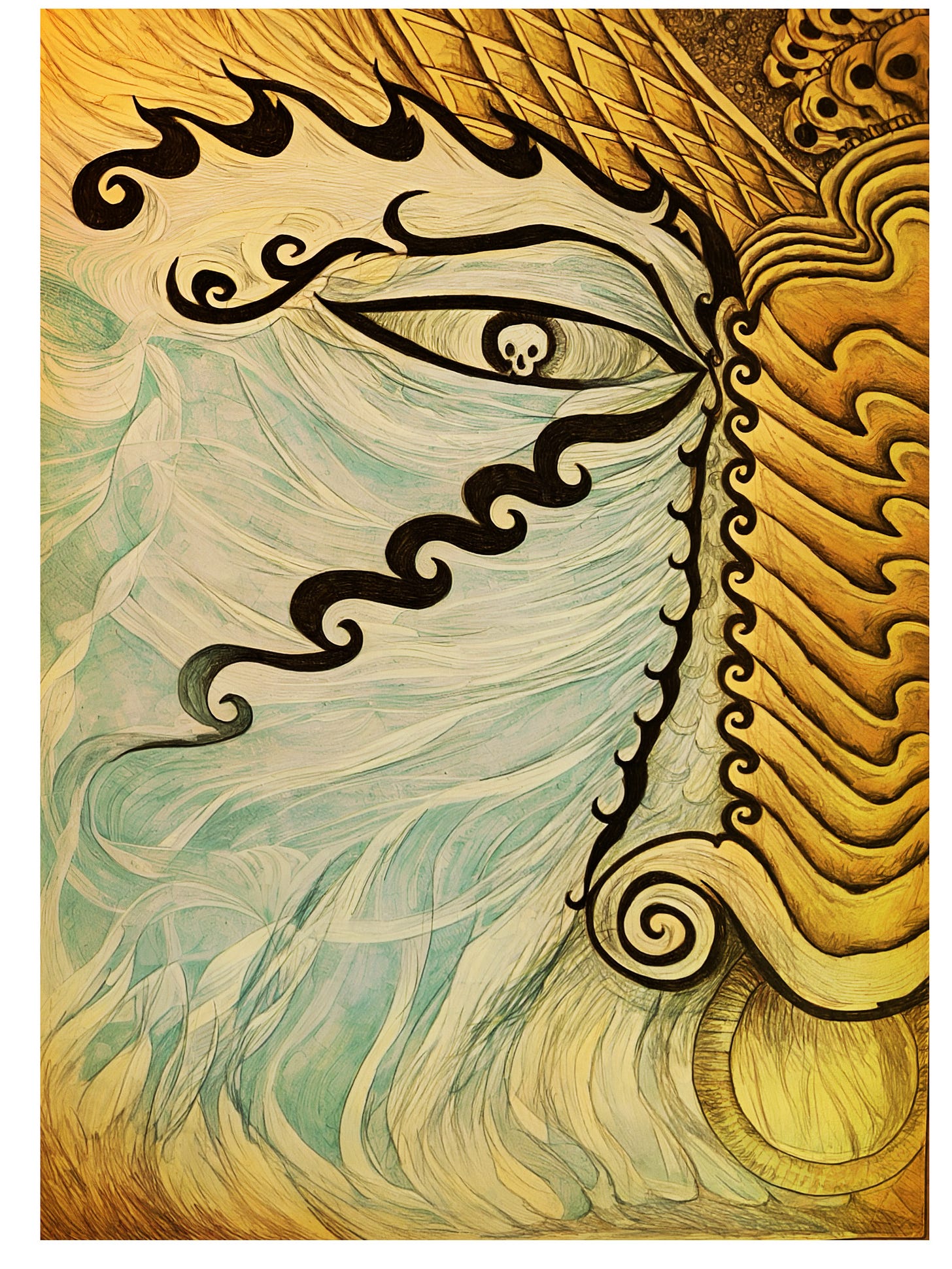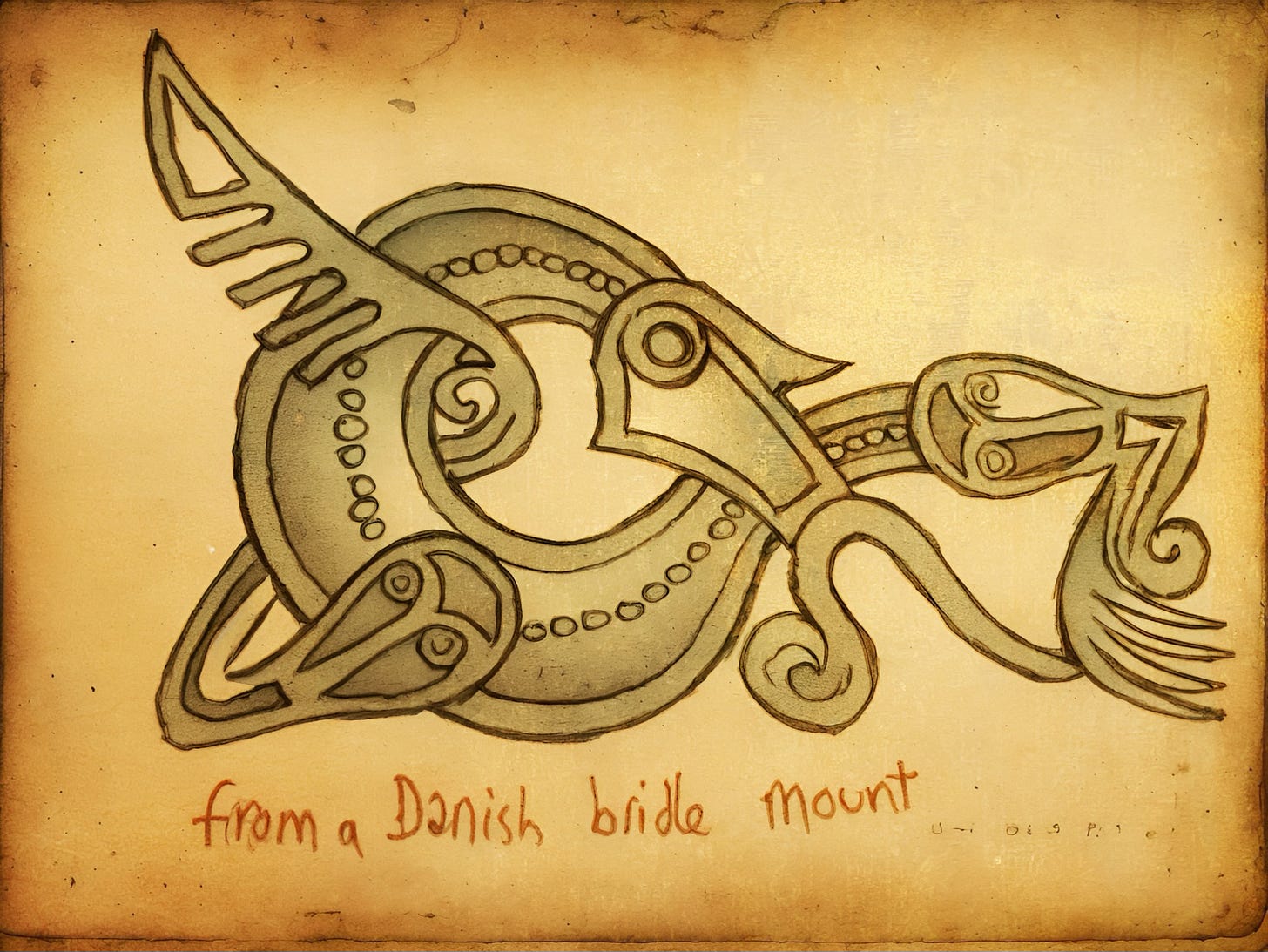That fierce spirit
Guest called Grendel
Famed border walker
He who occupied the wastelands
Fen and fastness
The homeland of the giant-race
In the saga, Beowulf, the hero’s first foe is named, Grendel. The language used to describe him is specific – the liminal ground: the moor, the mere, the fen and forest are his haunts. He’s associated with references to bodies of water (fifelcynnes eard – realm of the water beasts). In the deep, dark waters are the halls that belong to Grendel’s mother. These waters are filled with serpentine monsters.
Being written in the Christian era of the ninth or tenth century AD, the tale relates events hundreds of years earlier. Of course, Beowulf’s scribe imposed Christian origins to Grendel and his Mother. They were Caines Cynn, the Children of Cain: the biblical wrong-doer par-excellence, who was often used as the source of many a beastie by medieval scribes.
Grendel is more than this though. He is an ogre, a fiend, a wight, he stalks the night; a dark shadow of death. His affiliations with death and the realm of the dead are plain to see. His assaults upon the famed hall of Hroðgar, Heorot*, take place at night. Tellingly they happen while those in the hall slumber and while warriors rest. He is the ultimate nightmare.
For twelve years Grendel causes terror upon Heorot. That is until Beowulf comes from across the sea, vowing to defeat the beast. This task he performs with his bare hands, ripping Grendel’s arm from its shoulder and hanging it above the door as a ward. Mortally wounded, Grendel slinks off to his underwater cave to die.
It’s hard not to read Beowulf and notice something that is common to ancient lore across the Old World. In total, Beowulf’s foes number three. I believe this triplicate enemy is no accident, but hints at a form that underpinned Indo-European society even into the Christian era. This triplicate nature has been discussed by me before (SEE). Beowulf’s foes are:
1: Grendel, who steals into the halls to slays all, claiming Heorot as its own.
2: Grendel’s mother, also drawn to the hall, this time seeking revenge, after which she flees to her lair. Beowulf swims down to confront and slay her there.
3: Finally there’s the dragon who guards a horde of treasure within a barrow. This last foe is the undoing of Beowulf, for although he slays it, its poisonous bite kills him.
The theme of hero slaying a monster that dwells within a watery domain is another vital component of ancient myth. It’s clear that the underpinnings of this tale are very ancient, and as Indo-European tribes branched out, east and west, the story went with them. As with all stories, character names changed, and the scenery was replaced by that which could be related to.
The Mesopotamian mother of dragons, Tiamat, bears striking similarities to Grendel’s mother. She births monsters and is slain by a hero. As I’ve pointed out in other posts (SEE) this is a recurring theme that can be interpreted on various levels. The most obvious is the triumph of chaos over order. However, with the characters of Beowulf, I’d suggest another interpretation, building upon this theme. Grendel and his mother are elements of the wilderness; embodiments of the wild, unknown places. The chaos of nature that the ancients both respected and feared.
Grendel is drawn from his lair to the lights of Heorot*. As raging spirits of the wilds, they are not anti-life, as some suggest, but despisers of domesticity, scorning the settled ways of men. The Hall of Heorot is carefully erected within our minds by the skill of the bard. It is tall and mighty, horn crested, huge between its antlers. The hall is the focal point for the Danish tribe of the Scyldings, whose king is Hroðgar. It is built by the king to celebrate their victories. There the people meet to feast and sing, play music and recite the tales of their heroes. The sound is tormenting to Grendel, the society of men is tormenting to him.
This mirrors part of the Tiamat myth: Apsu, Tiamat’s male counterpart, is driven to distraction by the noise of the gods. It is he who originally confronts the gods and is slain by them. The gods then reside within Apsu, disturbing Tiamat. There’s a really close semblance between the two myths here.
Taking it further, we could also assume that there is something else which Grendel and his mother embody. Even though Danish society in the time of the Scyldings was pagan, we have to remember that the version we have of the tale was written by a Christian hand. Biblical references litter the text. Given this context, it’s hard not to feel that the monsters of the tale hint at the older beliefs. Rather, they are literary manifestations of the negative emotions the Christian scribe feels toward the old religion. It is the stew of demons and devils.
Beowulf’s final foe is the dragon, dwelling beneath the ancient mound of a warrior king long gone. Like the other beasties in the saga, the dragon raids at night, but only because a thief disturbed the tomb**. With the intent to subdue another monster, Beowulf sets out. But the dragon is the hero’s doom, and it is a young thane, Wiglaf, who lands the killing blow.
Denmark is filled with such ancient barrows. Many well-preserved bodies and treasures of the Bronze Age culture that erected them have come to light. Finds of this period include the Goddess and Her serpent consort. The union of Serpent and Goddess is well attested in the core of such legends (SEE). Here we find evidence of age-old echoes, where myth and materiality intertwine, like the artistry of an ancient design.
Notes:
*Heort is the Old English word used in the original text, and means Hart. The use of a prey animal for the hall is intentional. It conjures up the imagery of something magnificent, noble. But their is a fragility to the image, for ultimately the stag is at the mercy of the hunter.
**This imagery is iconic, and no doubt inspired Tolkien’s Ring cycle and the dragon, Smaug.
References:
The Mound People – PV Glob
The Literature of Ancient Sumer – Black, Cunningham & Zólyomi
Beowulf – Bloom’s Guides
Beowulf – J. Leslie Hall
Beowulf – J.R.R Tolkien
Elves in Anglo-Saxon England – Alaric Hall
Python: a study of Delphic Myth & its Origins – Joseph Fontenrose
Gods & Goddesses of the Celtic Realms – Dave Stone
Cut and paste it in your search bar ;)







